Ruins, Trees, Stories, and Song
My journey to Siem Reap and Cambodia's majestic Angkor temples
Hi friend! Happy Valentine’s Day to those who celebrate. I’ve taken a bit of a break from sharing stories from my travels throughout Asia as I’ve been busy writing about other things (such as aliens under the ocean and whether or not the earth is speaking to us), but I have so many, and Ink Roads did begin as a travel blog…so I’m picking up where I left off, on my very first day in the extraordinary country of Cambodia.
*
I left Thailand with no small amount of regret, vowing I’d return someday to the country I’d loved so much. But when I touched down in Cambodia, I immediately felt at home in a whole new way.
I called a tuk-tuk from the airport on the ever-useful Southeast Asia transit app Grab, not realizing the airport was actually quite far from Siem Reap city center. We inched along on the side of the highway at what felt like a glacial pace, but the slow journey allowed me to see the sprawling fields and jungles of the country I’d just arrived in.
My plan at the time was to stay in Cambodia for less than a week, but that week would turn into two and eventually into a nearly two-month stay — a common occurrence for travelers who pass through Cambodia, apparently, but of course I did not know that at the time.
At last I arrived at Siem Reap and checked into my extremely cheap hotel, which was luxurious by any standard. A blue pool glowed invitingly just outside my door. The moment I arrived in my room, a cat emerged from outside and began meowing. I let her in, and she leapt up on my bed. It felt like a good omen, I decided. A welcome cat. A sign I was on the right path.
I’ve often found that when you start looking for signs, you start seeing them everywhere.
The next day, still fresh off the motivation of the mental health retreat I’d attended in Thailand just a few weeks before, I bounded out of bed at seven in the morning and did some yoga and meditation. Then I visited a cafe called Biolab, which might be one of the best cafes I’ve been to in the entire world in terms of spaciousness, design, and smoothie quality.
I spent the rest of the day wandering around Siem Reap, a city that surprised me with its loveliness and homey feeling. I’d later come to fall in love with the city, with its blend of cafes and pleasant restaurants, its glittering lights and swaying palm trees, and its safety, friendliness, and warmth.
There’s a rule that no buildings in Siem Reap can be built taller than Angkor Wat, so there aren’t any skyscrapers, and this naturally keeps the population density down and helps to give it a calmer and more relaxed feel than any other major city I’ve been to.
Of course, its good energy is also thanks to the Cambodian people, who were unilaterally absolutely lovely, friendly, funny, helpful, and sweet to me. Many times people thanked me — quite genuinely, it seemed — for visiting their country.
Cambodia is very much up-and-coming as a travel destination, and it is also still rebuilding itself after the tragic and horrific genocide committed by the Khmer Rouge in the 1970s. Tourism is a big part of this shift, though of course everyone feels a bit differently about the influx of foreigners coming into the country. Most of the locals I met along the way, though, seemed extremely happy to have visitors.
On my first full day in Siem Reap, I visited the Angkor Museum, which paid tribute to the Khmer Empire’s glory days. Cambodia’s ancient history is so rich and fascinating, and its religious lineage is a tapestry of Hinduism and Buddhism that culminated in the creation of the world’s largest religious monument — the iconic Angkor temples.
In the museum, I wandered through a room that contained a thousand Buddhas of all shapes and sizes. In the solemn half-light of the dimly lit hall, I encountered a plaque that told the story of how the Buddha had been visited and protected by an earth goddess during his fight against Mara, which directly preceded his enlightenment.
I would describe my present faith as a version of eco-spirituality, and I think earth-based faiths and Buddhism work in tandem perfectly, so it was fascinating to read about how this partnership is embedded in the ancient scriptures. The earth has always been a key ally in any search for wisdom, ascension, and connection —a fter all, it is us. I always say that by watching the cycles of its seasons and the way nothing is wasted and everything is connected, we can learn all the lessons we will ever need to know.
We need the Earth, I think, in any search for any sort of wisdom or peace; these things are not found outside the world, but within it, in its moss and ruins, in its storms and rain and stars.
I was also moved by descriptions of how benevolent some of the ancient kings were, particularly Jayavarman VI and his first and second wife, who apparently built massive systems of public works such as hospitals that catered to the poor. In one room, I wandered through huge stone tablets that were inscribed with old Khmer script which tracked rice donations and medical supplies sent to hospitals.
This is a stark contrast to Cambodia’s government today, I’d quickly come to find out (and to America’s government today, which is a whole other story). I’ll write more about and about the genocide that in my upcoming post centered around my time in Phnom Penh.
But in Siem Reap, my goal was to go back in time — way back. The next day I took a tuk-tuk to catch my first glimpse of the Angkor temples.
*
My guide, Kim, rolled up in a decked-out tuk-tuk complete with cold lemon-scented towels, lotuses, and rainbow flags that fluttered from every side. I’d been inundated with drivers offering to take me around the temples from the moment I set foot in Siem Reap, but her website had proclaimed that she was Cambodia’s first female tuk-tuk driver, which made her an easy choice. (If you ever find yourself in Cambodia, you can hire Kim here).
Kim first drove me to Ta Prohm, which today is commonly known as the Tomb Raider temple, since it was featured in the classic Angelina Jolie film. I had wanted to visit the temple ever since I saw a photo of it — draped in mammoth fig and silk cotton trees, the temple is a prime example of nature’s ability to reclaim even the greatest of human achievements.
In the end, no matter how much blood we shed or bombs we drop or towers we build and destroy, all things will one day return to the trees and the soil and eventually, back to the stars and dust it all emerged from.
I walked down a long tree-lined path. Faint music grew louder and louder, and at last I passed by a band of musicians playing a series of instruments I’d never seen before. A sign proclaimed that they were victims of landmine explosions. Most of them were missing limbs.
Eventually I made it to the temple. It was a misty, quiet, damp morning, and thick layers of moss glittered on the stones. Huge trees — so huge they almost looked fake — had threaded themselves through every one of the stone halls of the crumbling, labyrinthine building.
Though it was early, the temple was crowded, and I found myself wishing I had it to myself so I could sit and soak it up. As it was, there was no real space to sit anywhere, and large crowds kept pushing past me.
Still, the blend of sacred stone carvings and trees gave the temple an unmistakable aura of mystery and magic. It is definitely one of the wonders of the world.
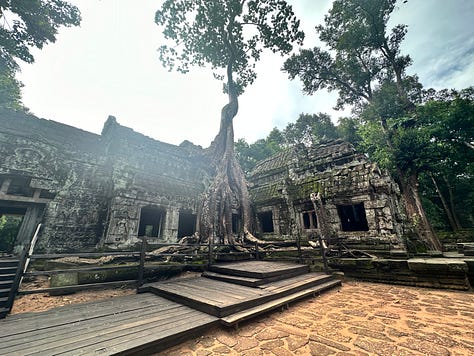




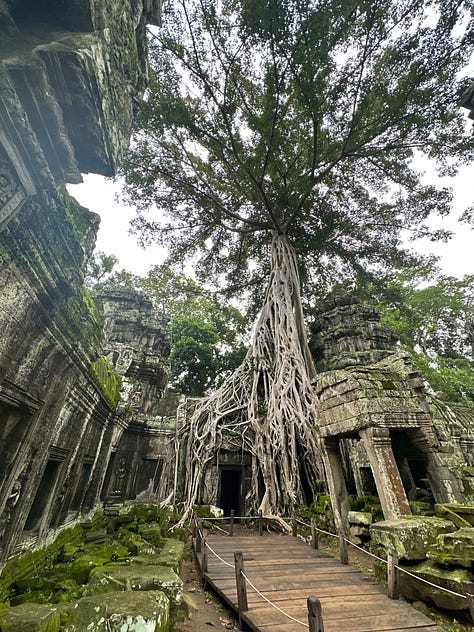
I believe there is a great deal of wisdom to be found in ruins. We can learn so much from the ways the earth and the elements lovingly reclaim broken things. In the arms of nature, nothing is broken; instead everything is integrated into the weave and web of existence.
These temples were lost for centuries, but nature found a way to grow into them, through them, with them. And so, I think, can we, in our ruined, crumbling, changing world.
After wandering around the temple for a few hours thinking about all this, I made my way back to the parking lot. As we drove, Kim spoke about her life as a single mother and life in Cambodia in general. She told me that she’s concerned for young people in particular, as drinking is common, with many people drinking every single night, and many children don’t want to go to school, she added. Her face contorted with pain as she spoke and it was clear how much she cared. She also had plans to go to the government about various regulations and protections for tuk-tuk drivers, she said, and was helping to organize the small but growing group of female drivers working in Cambodia.
It was also growing hotter and I was feeling immensely grateful for the cold lemon cloths Kim had kept cold on a block of ice. In between her stories, I sweated heavily as I walked up to some temples in the bright sunlight and as I walked across a long lotus-filled pond towards a hidden lake with a temple rising up out of its core.
The temples were endless, a dizzying array of smiling faces and stones emblazoned with all manner of ancient stories. Shivas and Buddhas and countless Apsaras, or bejeweled court dancers, gazed from the walls.
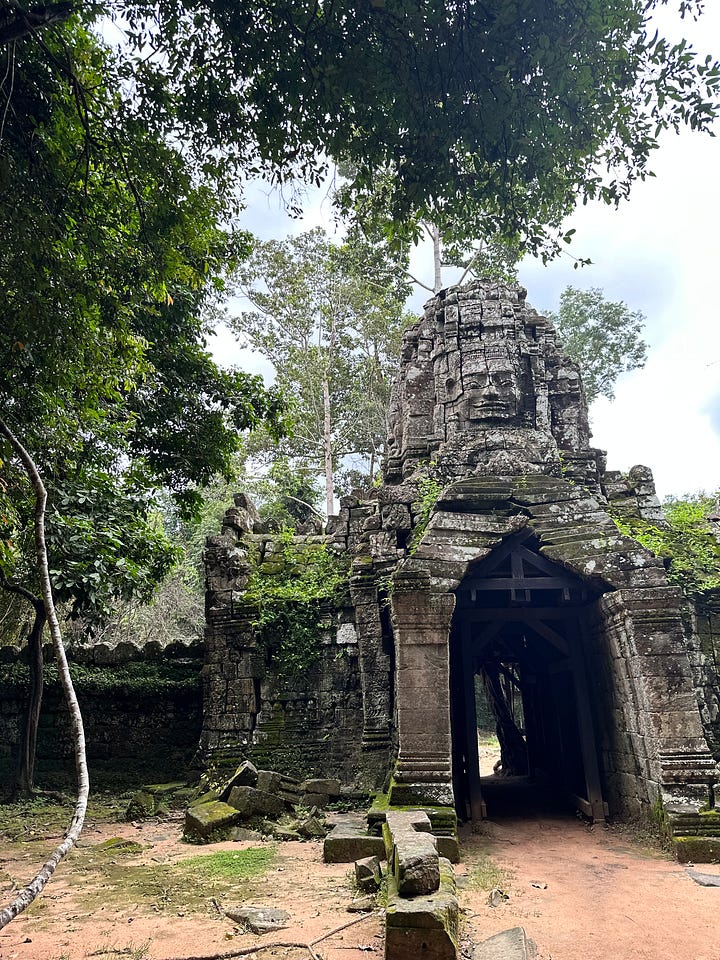

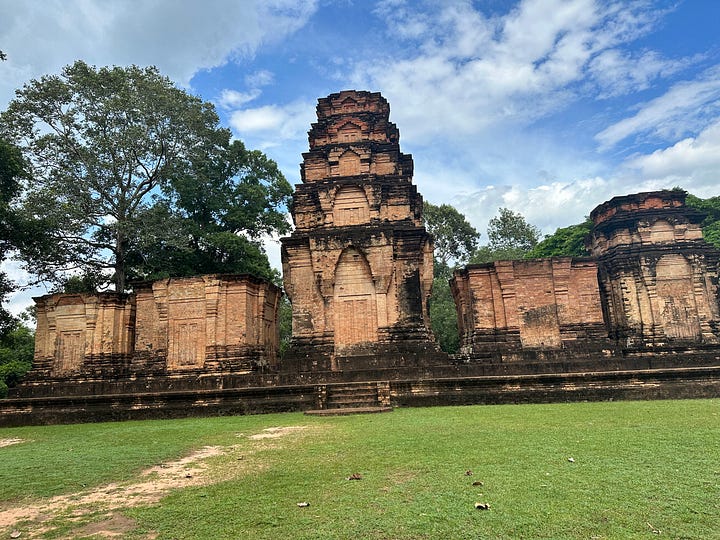

On our way back, we found ourselves stuck in traffic for over an hour due to a…car show, of all things. Hundreds of gaudy, shiny red and silver vehicles (I truly cannot even begin to guess what kind) crept through the streets, presenting a strange contrast to the ancient temples and dense forests in the background. This was evidence of Cambodia’s efforts to modernize, clearly — to join the flow of capital and development that so much of the world rides upon.
*
The next day I set out for Angkor Wat itself, which is the grandest temple of all. Kim picked me up just before sunrise. Wanting more information about the temples, I had enlisted the help of a guide who joined me in Kim’s tuk-tuk, and he also came with a wealth of stories and wisdom.
He had been a monk, he explained, and now woke up every single morning at three to meditate for one hour. He spoke of Buddhism and its fundamental truths as we wound our way through the halls of Angkor Wat, observing detailed carvings of ancient battles and creation myths.
Monkeys scaled the walls of the building. Everything glowed in the early morning sunshine. Rain threatened and wept a bit but never fully broke.
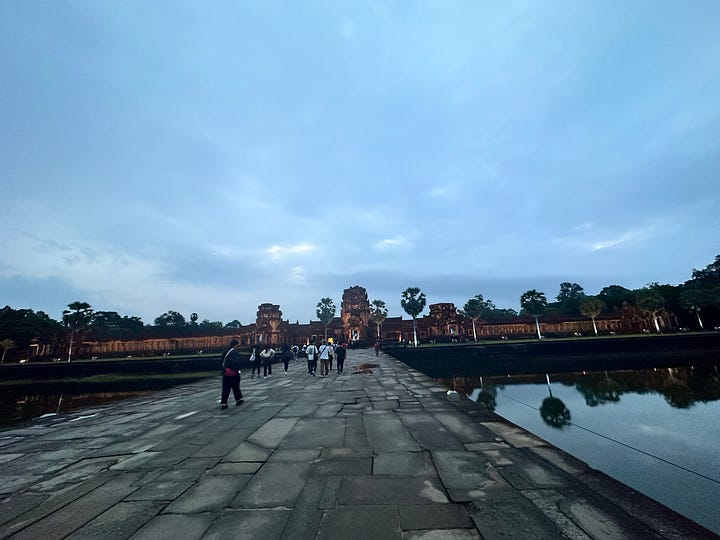


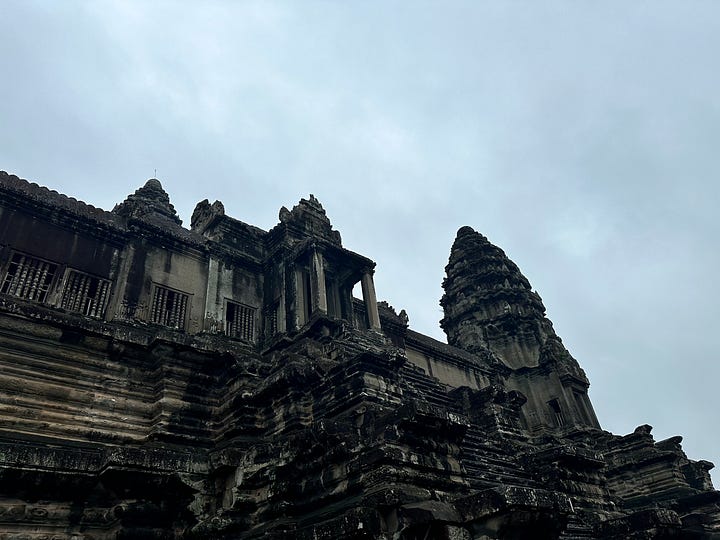
In the afternoon we made our way to a hall of demons, which was designed to symbolize what you might find in the hell realms if you generate enough bad karma. Then we visited Ta Prohm again, this time so the guide could explain its history in more detail. And really, I think the pictures say more than words can.
For a bit more history and more information about Angkor Wat itself, you can read another article by me here about this same day.
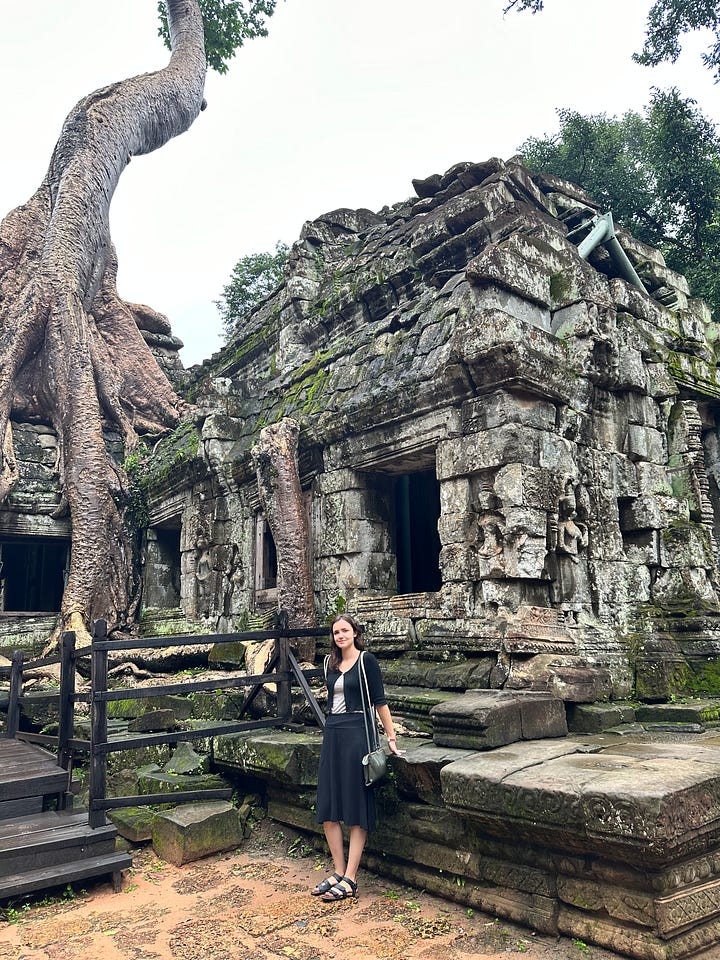


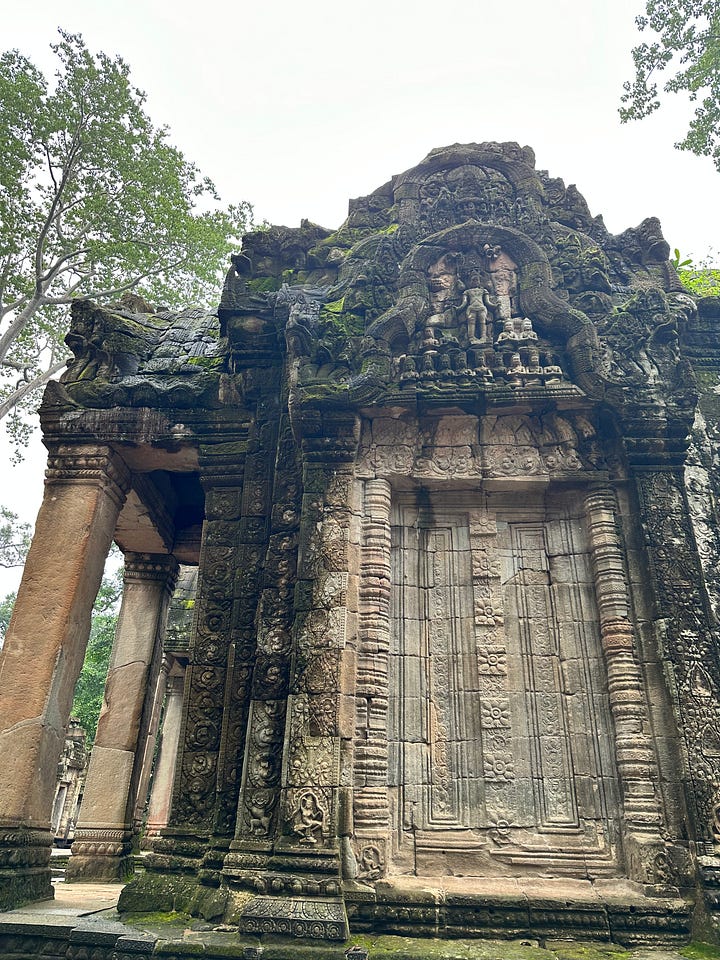
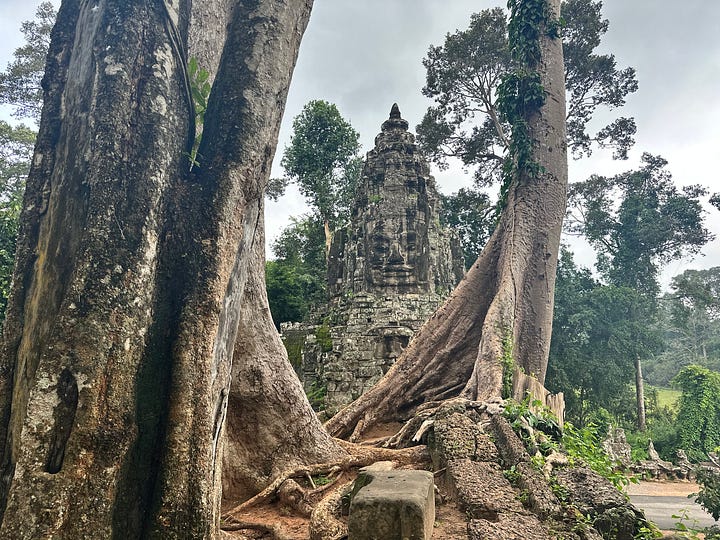
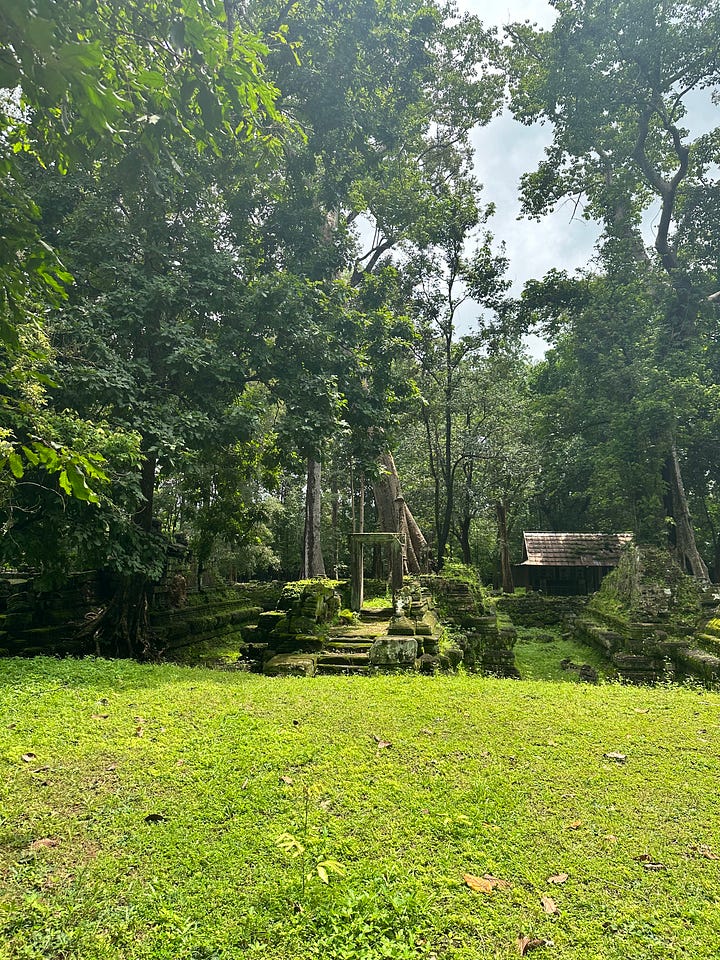


It turned out that my guide was also a musician, and after I said I was as well, we made plans to meet at a hostel that evening. I arrived at the pool sporting my small guitar to find that he also had his in hand, as well as a handmade book of songs featuring lyrics and chords in English, Thai, and Khmer.
He had some of my favorites in there, and we sang Knockin’ on Heaven’s Door, Fire and Rain, and House of the Rising Sun by the pool. He also told me about his childhood, spent listening to bombs fall and hiding underground with his family.
As always, music was a unifying force. Music and stories and art transcend time and space and differences of any kind. The temples themselves are art, too — creative works of beauty created in tribute to gods and kings that bind us together across timelines and all manner of divides, decay, and change.
Stories outlast tragedies. They grow out of despair like trees. They guide us home. They are part of us, part of what makes us alive.
So thanks for being here, and taking the time to read some of mine.




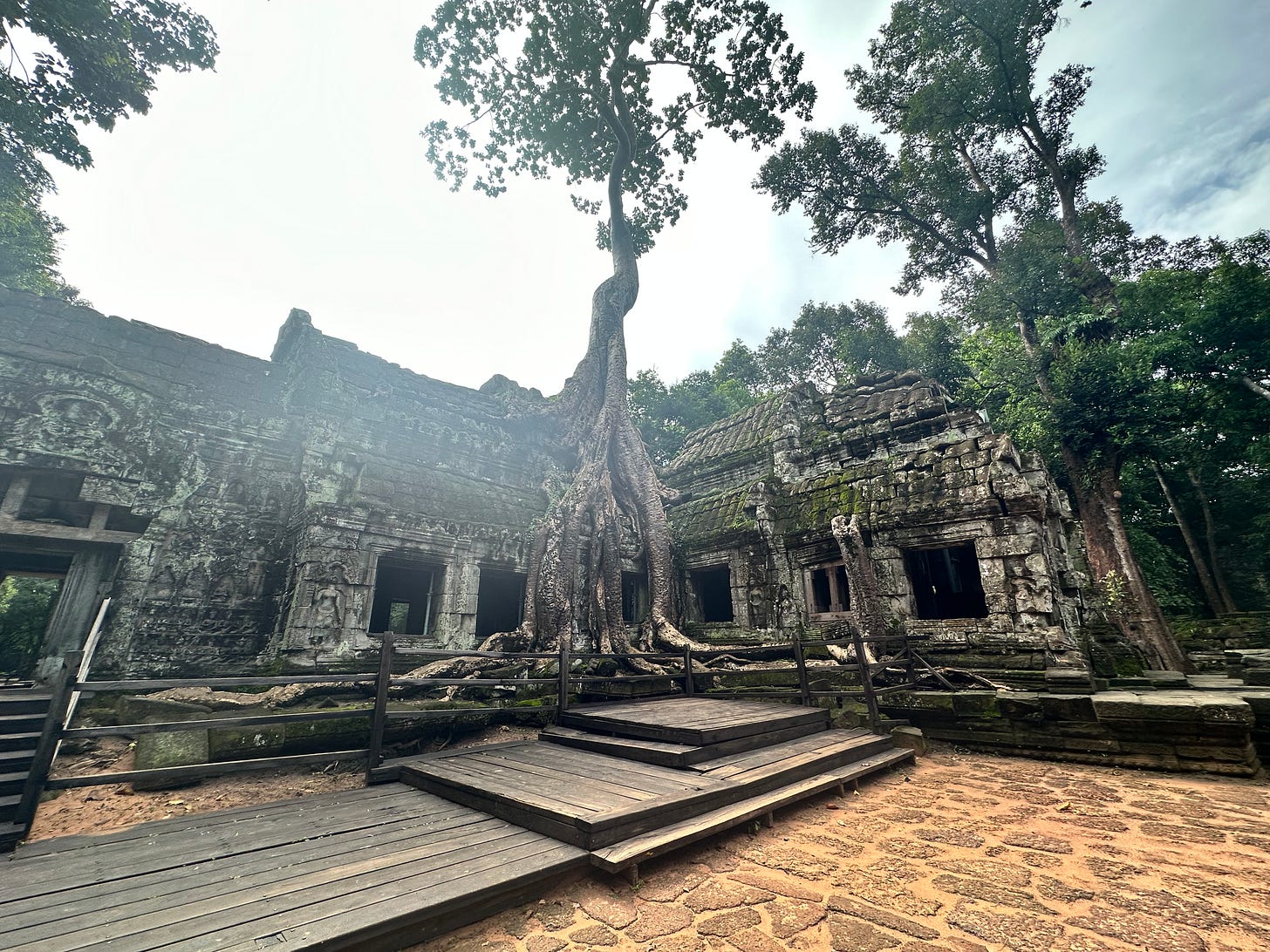
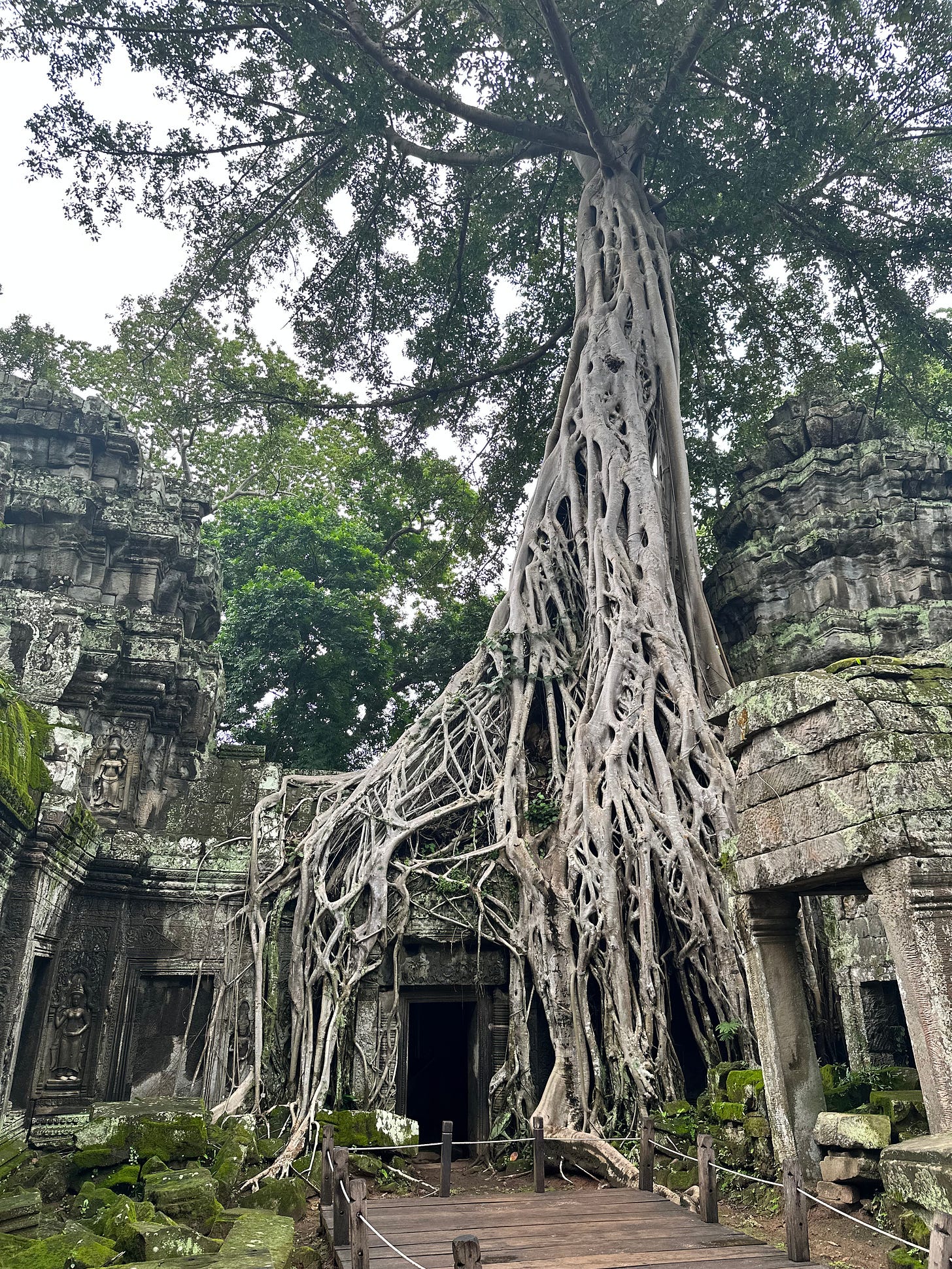
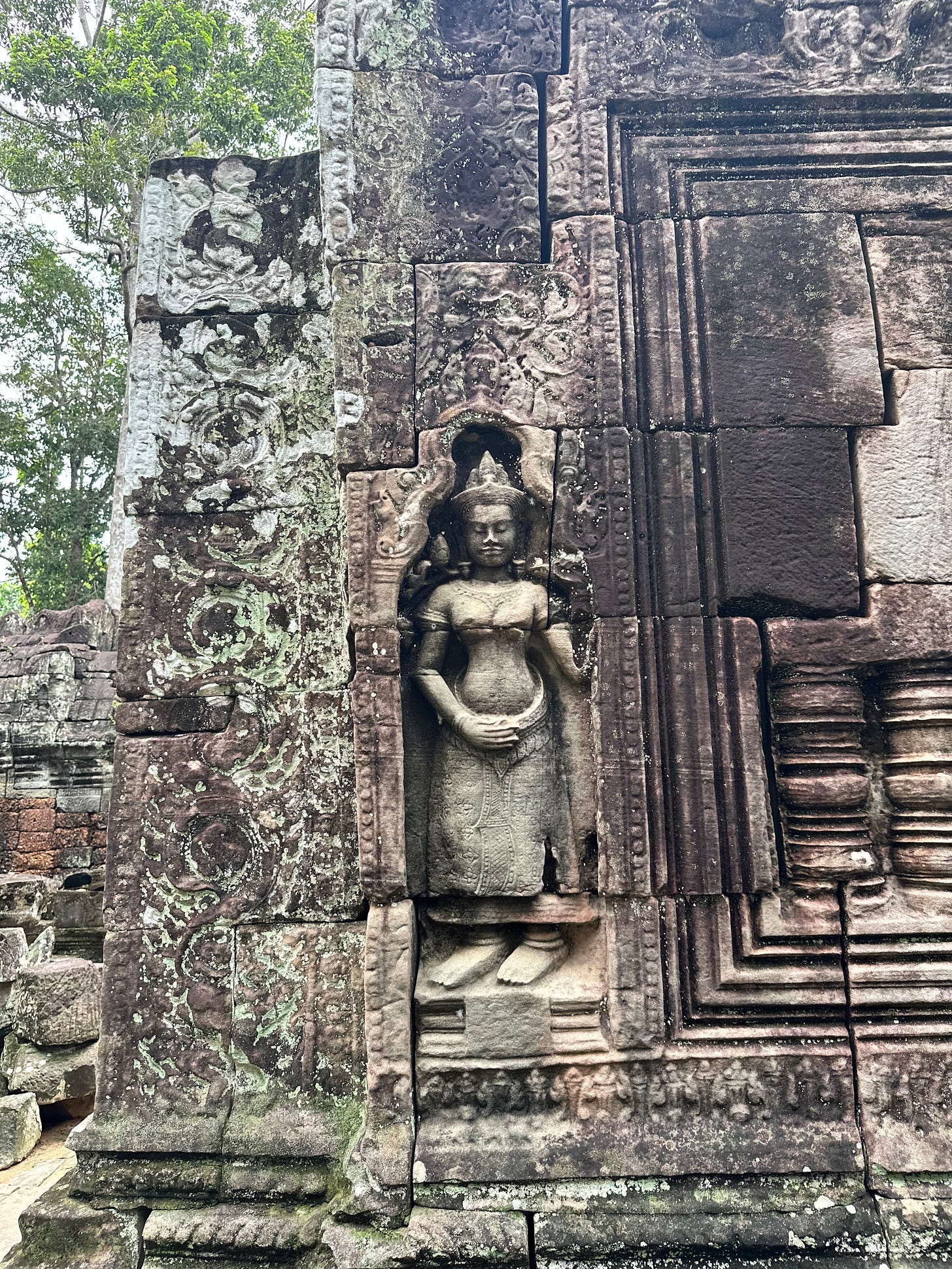
Those trees are unnerving, in a sense. They don't appear as the more familiar new life reclaiming old ruins, but they seem to mirror the age, the dissolving and shifting of form, the overall energy of the place, as if the stone is alive and they are feeding upon it, encasing it in a web and transmuting it to trunk and root and leaf.
One of my favorite places I've ever traveled to! Thanks for sharing your impressions and photos here. It took me back.